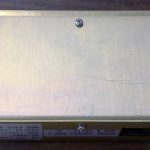
The show must go on! Power surges, lightning strikes, and just sheer component aging are all problems our broadcaster customers deal with often – especially with their damaged power supplies. Keeping good backups around is key to making sure the show DOES go on! Good surge protection can also help prevent disaster. Knowing where and how to get fast and reliable power supply repairs, monitor and signal analyzer repairs is also critical!
These pictured damaged television broadcast power supplies are just two of the MANY that have come in to us for repairs.


This Vinten power supply AM-SP-2000PS came in for repairs with a “low voltage” problem. Aging components – primarily the output module was the problem. The Power Supply Concepts unit, PSC221/, came in with a “no voltage output” problem. Damaged components were replaced including capacitors and resistors. Both units were successfully repaired, cleaned, tested and back to work in the broadcast business!
Our tech team has provided equipment evaluations and repairs for more than 88 television broadcast stations from all over the U.S. and Canada! Monitor, signal analyzer and power supply brands serviced include ELO, Barco, APC, Harris, Vincent, Power One, Lambda, Pioneer Magnetics, Ross, Agilent, Hitron, Emacs, TK Power, Switching Power, ASTEC, 3M Microtouch, Nortech Engineering, Mean Well, Jeta Power Systems, Vicor, Ablecom, Tectrol, Harmer Simmons, Sony, Technology Dynamics, Tektronix, Todd Products, AcBel, Sincho, Deltron, Vinten, and more.
None of this may sound very dramatic unless YOU are the one whose broadcast can’t go on because you are suffering equipment failure or damage and don’t have a working backup! It is true that occasionally the damage is too catastrophic or not cost efficient to repair. But MOST of these broadcaster power supplies, monitors, and signal analyzers WERE repairable.
To Trouble Shoot or to NOT Troubleshoot?
That is the question many customers have. It all depends on the skill sets you or your team have and the time you’ve got to deal with the problem. If you’ve got the skills, the safety knowledge to prevent getting injured, and the time, then troubleshooting may be in the cards. If not, stop reading here and call your power supply repair depot!
Still reading? Power supplies are everywhere and pretty much nothing runs without them. The power supply unit is one of the most critical components in any automation system. Power supplies frequently exhibit intermittent problems and have low wattage. Or, sometimes they are just simply “dead” or “no output”.
You might see an “error” LED on a DC power supply has turned on. Your task then is to determine if the problem is the power supply, the input supply voltage, or a load change on the demand side of the unit.
At this point you can measure the line input voltage, and see that checks out. Then you can check the DC output voltage. Now, if you have a spare, you could swap out the bad PSU with a known good replacement unit. If everything is working, you will know it is that power supply.
Still having problems? Do you have an oscilloscope? If so, then consider checking the PSU’s input and output waveforms with the oscilloscope. Connect the oscilloscope to the power supply’s AC line input terminals and check the input waveform for any fluctuation, distortion, or dropouts. You want to see that the AC line voltage is a perfect sine wave. If the AC supply voltage is good, you would now consider checking the DC output voltage.
If there are still no obvious problems, your could then try checking the PSU’s input and output waveforms over time. This could tell you the fault is in the AC supply, not the PSU. Still not the problem? Then you need to check the power supply’s (PSU’s)DC output voltage over time by placing a clamp on one of the DC supply conductors and connect the clamp to the channel A of the oscilloscope. Then connect channel B to the power supply’s DC output voltage. You can plot both the output current and voltage over time.
Consider that the load current might exceed the maximum rating of the power supply at various times which causes it to drop out. Next consider looking to see what might be drawing too much current. Or maybe you just need a BIGGER power supply! If you have done all of this and are still stuck, it is past time to get some professional help!
If you think you need power supply repairs check first to see if your equipment is still under warranty. If so, contact the OEM about repairs. If it is out of warranty, hopefully you have a go-to repair center.
If not, contact an independent industrial electronic repair center to find out if they are a good fit for your company and your particular repair needs. They should offer free evaluations and q for your damaged power supplies, monitors, signal analyzers and other equipment, and a free quote for repairs (no bench fees!). They should also provide repair reports if requested and a good warranty of at least one year that covers both parts and labor.
About the Author: ACS Industrial Services is an independent industrial electronic repair center providing Vinten power supply repairs AM-SP-2000PS, power supply repairs for all types and manufacturers, circuit board repairs, repairs for drives, servo motors, CNC equipment, encoders, monitors and touchscreens, PLCs, HMIs, test equipment, and much more. Rush Service is available and Two Year Warranties cover most repairs. The very helpful customer service team is available to answer your questions and help you solve your toughest industrial electronic repair problems. You can reach them by calling 800-605-6419 or going to www.acsindustrial.com.
